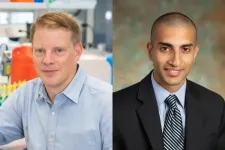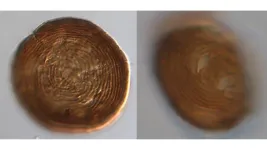(Press-News.org) BUFFALO, N.Y. — The image spoke for itself.
University at Buffalo computer scientist and deepfake expert Siwei Lyu created a photo collage out of the hundreds of faces that his detection algorithms had incorrectly classified as fake — and the new composition clearly had a predominantly darker skin tone.
“A detection algorithm’s accuracy should be statistically independent from factors like race,” Lyu says, “but obviously many existing algorithms, including our own, inherit a bias.”
Lyu, PhD, co-director of the UB Center for Information Integrity, and his team have now developed what they believe are the first-ever deepfake detection algorithms specifically designed to be less biased.
Their two machine learning methods — one which makes algorithms aware of demographics and one that leaves them blind to them — reduced disparities in accuracy across races and genders, while, in some cases, still improving overall accuracy.
The research was presented at the Winter Conference on Applications of Computer Vision (WACV), held Jan. 4-8, and was supported in part by the U.S. Defense Advanced Research Projects Agency (DARPA).
Lyu, the study’s senior author, collaborated with his former student, Shu Hu, PhD, now an assistant professor of computer and information technology at Indiana University-Purdue University Indianapolis, as well as George Chen, PhD, assistant professor of information systems at Carnegie Mellon University. Other contributors include Yan Ju, a PhD student in Lyu’s Media Forensic Lab at UB, and postdoctoral researcher Shan Jia.
Ju, the study’s first author, says detection tools are often less scrutinized than the artificial intelligence tools they keep in check, but that doesn’t mean they don’t need to be held accountable, too.
“Deepfakes have been so disruptive to society that the research community was in a hurry to find a solution,” she says, “but even though these algorithms were made for a good cause, we still need to be aware of their collateral consequences.”
Demographic aware vs. demographic agnostic
Recent studies have found large disparities in deepfake detection algorithms’ error rates — up to a 10.7% difference in one study — among different races. In particular, it’s been shown that some are better at guessing the authenticity of lighter-skinned subjects than darker-skinned ones.
This can result in certain groups being more at risk of having their real image pegged as a fake, or perhaps even more damaging, a doctored image of them pegged as real.
The problem is not necessarily the algorithms themselves, but the data they’ve been trained on. Middle-aged white men are often overly represented in such photo and video datasets, so the algorithms are better at analyzing them than they are underrepresented groups, says Lyu, SUNY Empire Professor in the UB Department of Computer Science and Engineering, within the School of Engineering and Applied Sciences.
“Say one demographic group has 10,000 samples in the dataset and the other only has 100. The algorithm will sacrifice accuracy on the smaller group in order to minimize errors on the larger group,” he adds. “So it reduces overall errors, but at the expense of the smaller group.”
While other studies have attempted to make databases more demographically balanced — a time-consuming process — Lyu says his team’s study is the first attempt to actually improve the fairness of the algorithms themselves.
To explain their method, Lyu uses an analogy of a teacher being evaluated by student test scores.
“If a teacher has 80 students do well and 20 students do poorly, they’ll still end up with a pretty good average,” he says. “So instead we want to give a weighted average to the students around the middle, forcing them to focus more on everyone instead of the dominating group.”
First, their demographic-aware method supplied algorithms with datasets that labeled subjects’ gender — male or female — and race — white, Black, Asian or other — and instructed it to minimize errors on the less represented groups.
“We’re essentially telling the algorithms that we care about overall performance, but we also want to guarantee that the performance of every group meets certain thresholds, or at least is only so much below the overall performance,” Lyu says.
However, datasets typically aren’t labeled for race and gender. Thus, the team’s demographic-agnostic method classifies deepfake videos not based on the subjects’ demographics — but on features in the video not immediately visible to the human eye.
“Maybe a group of videos in the dataset corresponds to a particular demographic group or maybe it corresponds with some other feature of the video, but we don't need demographic information to identify them,” Lyu says. “This way, we do not have to handpick which groups should be emphasized. It’s all automated based on which groups make up that middle slice of data.”
Improving fairness — and accuracy
The team tested their methods using the popular FaceForensic++ dataset and state-of-the-art Xception detection algorithm. This improved all of the algorithm’s fairness metrics, such as equal false positive rate among races, with the demographic-aware method performing best of all.
Most importantly, Lyu says, their methods actually increased the overall detection accuracy of the algorithm — from 91.49% to as high as 94.17%.
However, when using the Xception algorithm with different datasets and the FF+ dataset with different algorithms, the methods — while still improving most fairness metrics — slightly reduced overall detection accuracy.
“There can be a small tradeoff between performance and fairness, but we can guarantee that the performance degradation is limited,” Lyu says. “Of course, the fundamental solution to the bias problem is improving the quality of the datasets, but for now, we should incorporate fairness into the algorithms themselves.”
END
Study: New deepfake detector designed to be less biased
With facial recognition performing worse on certain races and genders, algorithms developed at UB close the gap
2024-01-16
ELSE PRESS RELEASES FROM THIS DATE:
Researchers find that using patients’ own blood, rather than saline, helps preserve veins in coronary bypass grafts
2024-01-16
In a collaboration between the Fralin Biomedical Research Institute at VTC and Carilion Clinic, researchers learned that by preserving large superficial leg veins intended for coronary bypass grafting in a mixture of the anticoagulant heparin and blood, rather than heparin and saline, the veins were better protected from cell and tissue damage.
Their findings, published in January in the Journal of Vascular Research, could inform surgical practices and enhance the long-term success of vein grafts in coronary bypass surgeries.
“Ultimately, we're putting healthier blood vessels ...
What if cows could talk?
2024-01-16
You may not know it, but cows share information every time they burp, moo, and chew that speaks volumes about their health and welfare.
Through the work of researchers in Virginia Tech’s College of Agriculture and Life Sciences, we may soon know more about what cows are “telling” us and be able to use that information to improve their well-being.
James Chen, an animal data sciences researcher and assistant professor in the School of Animal Sciences is using a $650,000 grant from the U.S. Department ...
Allen Fawcett named Director of the Joint Global Change Research Institute
2024-01-16
By Greg Koller
COLLEGE PARK, Md.— Allen Fawcett — an energy expert and economist who has played a leading role in formulating and coordinating U.S. climate policy — is the new director of the Joint Global Change Research Institute.
Fawcett joined the Environmental Protection Agency in 2003 and, since 2012, served as the chief of EPA’s Climate Economics Branch, which advances the science of climate economics to inform policy. From 2010 to 2011, Fawcett took leave from EPA to serve as the deputy associate director for energy ...
Parents more likely to attempt suicide in first years after child’s cancer diagnosis
2024-01-16
Parents who have a child with cancer are more likely to attempt suicide during the first years after diagnosis, according to a new study conducted by Qianwei Liu of Southern Medical University, China, and colleagues, published January 16th in the open access journal PLOS Medicine.
Receiving a cancer diagnosis for a child is an incredibly stressful and distressing experience for parents. These parents, especially mothers, face an increased risk of psychiatric disorders, but little is known about the risk of suicide. In the new study, researchers looked at the number of suicide attempts ...
Energy-starved breast cancer cells consume their surroundings for fuel
2024-01-16
New study from the University of Sheffield identifies a novel mechanism employed by breast cancer cells to survive in the challenging environment within tumours
The findings provide a new insight into a previously unknown mechanism of cancer cell survival and may offer a new target for developing therapies
The research found breast cancer cells take advantage of nutrients in the extracellular matrix in times of nutrient starvation
Energy starved breast cancer cells ingest and consume their surroundings to overcome starvation, a new study has found.
The research, conducted by scientists at the University of Sheffield and published today (Tuesday 16 January ...
How did free wi-fi help unlock Hanoi wet markets’ mysteries?
2024-01-16
Researchers at the Alliance of Bioversity International and CIAT and their collaborators have been working on how to harness the power of the estimated 549 million Wifi hotspots worldwide, resulting in a project that used anonymized data gathered from free Wi-Fi to better understand the impact of COVID-19 on Hanoi’s wet markets during the first stage of the Covid-19 pandemic.
In the paper “Using free Wi-Fi to assess impact of COVID-19 pandemic on traditional wet markets in Hanoi” published in December 2023 in the scientific journal Food Security, the researchers analyzed and interpreted mobile device tracking ...
Smooth operation of future nuclear fusion facilities is a matter of control
2024-01-16
As researchers around the world work to develop viable alternatives to fossil fuels, the prospect of nuclear fusion—harnessing the same energy-generating reactions that power the sun—has grown increasingly attractive to private equity firms.
In 2022, the U.S. Department of Energy launched a partnership with investors in the private sector to accelerate the development of fusion energy, in part through the development of a fusion pilot plant, or FPP, in the United States.
The FPP and ITER—the world’s largest nuclear fusion reactor, currently being ...
Microfossils shed light on the long fossil record of euglenoids
2024-01-16
Hiding in the shadows, euglenoids are a fascinating group of single-celled protists that are neither plant nor animal. Plants photosynthesize, and animals eat. Euglenoids do both. Spiraling along the murky bottoms of shallow fresh-water ponds with their long flagella, they eat organic goop, while also using their chloroplasts to convert CO2 and water with light into sugars. Because of this in-between status, euglenoids have been placed close to the very base of the eukaryotic branch on the tree-of-life that includes ...
Amnesia caused by head injury reversed in early mouse study
2024-01-16
WASHINGTON - A mouse study designed to shed light on memory loss in people who experience repeated head impacts, such as athletes, suggests the condition could potentially be reversed. The research in mice finds that amnesia and poor memory following head injury is due to inadequate reactivation of neurons involved in forming memories.
The study, conducted by researchers at Georgetown University Medical Center in collaboration with Trinity College Dublin, Ireland, is reported January 16, 2024, in the Journal of Neuroscience.
Importantly for diagnostic and treatment purposes, the researchers found that the memory loss attributed to head injury was not a permanent pathological event driven by ...
Domesticating plants impacts their microbiome, study finds
2024-01-16
New research led by the University of Oxford indicates that human domestication of crops can alter the communities of microorganisms that are associated with plants. Intriguingly, independent domestication events were found to have similar impacts on the plant microbiome. The results have been published today in Current Biology.
Lead researcher Dr Riccardo Soldan (Department of Biology, University of Oxford) said: 'Our study provides evidence that regardless of where and how domestication took place, domesticated ...
LAST 30 PRESS RELEASES:
What determines the fate of a T cell?
Candida auris: genetic process revealed which could be treatment target for deadly fungal disease
Groundbreaking discovery turns household plastic recycling into anti-cancer medication
Blocking a key inflammatory pathway improves liver structure and vascular function in cirrhosis, study finds
Continuous spread: Raccoon roundworm detected in nine European countries
HKUST Engineering researchers developed a novel photodetector to enhance the performance of on-chip light monitoring
Strategic river sensors could have forewarned of Texas Camp flood disaster
Drone sampling of whale breath reveals first evidence of potentially deadly virus in Arctic
Roman soldiers defending Hadrian’s Wall infected by parasites, study finds
Pinochet’s prisoners were tormented with music but still found solace in it, a new book reveals
Fertility remains high in rural Tanzania despite access to family planning
AI-assisted device can improve autism care access
Kinetic careers
Uncovering how parasitic plants avoid attacking themselves to improve crop resistance
Nanoparticle vaccine strategy could protect against Ebola and other deadly filoviruses
Study finds brain care score can predict risk of stroke across racial groups
Key lung immune cells can intensify allergic reactions
Do hormones explain why women experience more gut pain?
New materials conduct ions in solids as easily as in liquids
Breakthrough of the Year: Renewable energy begins to eclipse fossil fuel-based sources
LLM use is reshaping scientific enterprise by increasing output, reducing quality and more
Introducing LightGen, a chip for ultra-fast, ultra-efficient generative AI
Astronomers see fireworks from violent collisions around nearby star
ACC/AHA issue new guideline on managing congenital heart disease in adults
Cosmic crash caught on camera
Is talented youth nurtured the wrong way? New study shows: top performers develop differently than assumed
Ants: An untapped resource in the development of antibiotics?
Archaeologists use AI to create prehistoric video game
Mitochondria migrate toward the cell membrane in response to high glucose levels
Tiny viral switch offers hope against drug-resistant bacteria
[Press-News.org] Study: New deepfake detector designed to be less biasedWith facial recognition performing worse on certain races and genders, algorithms developed at UB close the gap






